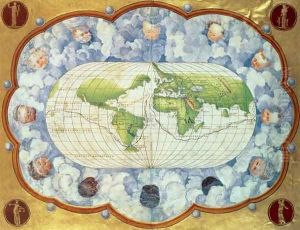Battista Agnese Paintings
Battista Agnese was a notable Italian cartographer who flourished during the 16th century, born around the year 1500. While not much is known about his early life, Agnese is most famous for his beautifully crafted portolan charts and atlases, which were highly sought after by patrons during the Renaissance period. He worked in Venice, which at the time was a major center of mapmaking and nautical chart production in Europe.
Agnese's work is characterized by its artistic quality and the integration of the latest geographical knowledge of his time. His charts are distinguished by their meticulous detail, vibrant colors, and ornate decorations, including elaborate compass roses, mythical creatures, and wind-heads representing classical wind gods. Despite the decorative nature of his maps, they were also practical tools for navigation, reflecting his understanding of contemporary cartographic knowledge.
Throughout his career, which spanned over three decades, Agnese produced over 100 manuscripts, including atlases and loose sheets, that have been preserved. His maps were highly prized by European nobility and were often given as prestigious gifts. They are a valuable resource for understanding the state of geographical knowledge and the art of cartography in the Renaissance.
Agnese's atlases typically included a world map, followed by regional maps covering areas such as Europe, Africa, Asia, and the Americas, which were being explored by Europeans at the time. Notably, his maps of the New World provide early representations of the continent following its discovery by Europeans.
Battista Agnese passed away in 1564, leaving behind a legacy as one of the preeminent cartographers of the Renaissance. His work has been studied extensively by historians of cartography and continues to be admired for its blend of scientific precision and artistic elegance. Today, Agnese's maps are held in numerous prestigious institutions and collections around the world, serving as a testament to his skill and enduring impact on the history of mapmaking.
